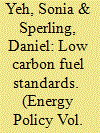|
|
|
Sort Order |
|
|
|
Items / Page
|
|
|
|
|
|
|
| Srl | Item |
| 1 |
ID:
105748


|
|
|
|
|
| Publication |
2011.
|
| Summary/Abstract |
China's vehicle population is widely forecasted to grow 6-11% per year into the foreseeable future. Barring aggressive policy intervention or a collapse of the Chinese economy, we suggest that those forecasts are conservative. We analyze the historical vehicle growth patterns of seven of the largest vehicle producing countries at comparable times in their motorization history. We estimate vehicle growth rates for this analogous group of countries to have 13-17% per year-roughly twice the rate forecasted for China by others. Applying these higher growth rates to China results in the total vehicle fleet reaching considerably higher volumes than forecasted by others, implying far higher global oil use and carbon emissions than projected by the International Energy Agency and others.
|
|
|
|
|
|
|
|
|
|
|
|
|
|
|
|
| 2 |
ID:
094911


|
|
|
|
|
| Publication |
2010.
|
| Summary/Abstract |
Local governments can have a large effect on carbon emissions through land use zoning, building codes, transport infrastructure investments, and support for transportation alternatives. This paper proposes a climate policy instrument - city carbon budgets - that provides a durable framework for local governments to reduce greenhouse gas emissions. Local governments would be assigned an emissions "budget", and would be required to keep annual local transport and buildings emissions within this budget. This policy framework could be implemented and managed by a higher-level government, or might be used in awarding funds to developing country cities from international climate funds. The state of California has enacted a version of this policy. In this paper, we identify and evaluate options for creating an effective and acceptable institutional structure, allocating emission targets to localities, measuring emissions, providing flexibility and incentives to local governments, and assuring compliance. We also discuss the likely costs of such a policy.
|
|
|
|
|
|
|
|
|
|
|
|
|
|
|
|
| 3 |
ID:
121260


|
|
|
| 4 |
ID:
099300


|
|
|
|
|
| Publication |
2010.
|
| Summary/Abstract |
Performance-based low carbon fuel standards (LCFS) of the type implemented in California and being adopted in the European Union, are a promising policy approach for decarbonizing transport fuels and reducing fossil fuel use. This paper examines the efficacy of LCFS policies, along with four major challenges that threaten their effectiveness. These challenges include leakage and shuffling of greenhouse gas (GHG) emissions, impacts on energy security, increased GHG emissions due to global land use conversion (indirect land use changes), and sustainability issues associated with biofuel production. We identify complementary policies that mitigate the severity of these challenges, while noting that some of these challenges are inherent to carbon and alternative fuel policies.
|
|
|
|
|
|
|
|
|
|
|
|
|
|
|
|
| 5 |
ID:
121266


|
|
|
|
|
| Publication |
2013.
|
| Summary/Abstract |
The use of biofuels can increase land competition, leading to global land use change (LUC). LUC poses risks such as increased greenhouse gas emissions and food prices. The magnitude of the risk is uncertain, but could be significant. Given these uncertainties and risks, we suggest that policymakers pursue a mix of the following three strategies: (1) promote feedstocks that rely less on land; (2) reduce LUC risk for land-using feedstocks; and (3) stimulate investments that increase land productivity and environmental protection. To realize these three strategies, we recommend that policymakers distinguish among feedstocks based on LUC risk; explore certifying production that avoids land competition; and adopt policy mechanisms that encourage investments in LUC-prone areas. We favor including feedstock-specific LUC emissions estimates in policies despite relatively large scientific uncertainty. While misleadingly precise, point estimates can be selected from science-based ranges to directly link LUC policy to emissions and provide strong transparent signals to biofuel investors. LUC emissions estimates can be updated regularly (~3-5 years) to reflect improvements in scientific understanding, and global changes in policy and economic environments. With or without LUC emissions point estimates, additional policies, some outside the biofuel sector, will be needed to pursue the three strategies above.
|
|
|
|
|
|
|
|
|
|
|
|
|
|
|
|
| 6 |
ID:
113442


|
|
|
|
|
| Publication |
2012.
|
| Summary/Abstract |
This paper addresses the policy challenges of adjusting established regulations to accommodate evolving and new technologies. We examine energy and emissions regulations for older petroleum powered vehicles and newer plug-in electric vehicles. Until now, vehicle regulations across the world have ignored energy consumption and emissions upstream of the vehicle (at refineries, pipelines, etc), largely because of the convenient fact that upstream emissions and energy use are nearly uniform across petroleum-fueled vehicles and play a relatively minor role in total lifecycle emissions. Including upstream impacts would greatly complicate the regulations. But because the vast majority of emissions and energy consumption for electric vehicles (and hydrogen and, to a lesser extent, biofuels) are upstream, the old regulatory design is no longer valid. The pressing regulatory question is whether to assign upstream GHG emissions to electric vehicles, or not, and if so, how. We find that assigning zero upstream emissions-as a way of incentivizing the production and sale of PEVs-would eventually lead to an erosion of 20% of the GHG emission benefits from new vehicles, assuming fixed vehicle standards. We suggest alternative policy mechanisms and strategies to account for upstream emissions and energy use.
|
|
|
|
|
|
|
|
|
|
|
|
|
|
|
|
| 7 |
ID:
149911


|
|
|
|
|
| Summary/Abstract |
We use biofuel patents as a proxy for biofuel innovation. Through use of natural language processing and machine-learning algorithms, we expand patent classification capabilities to better explain the history of biofuels innovation. Results indicate that after the initial establishment of the U.S. biofuel industry, there were two surges in biofuel innovation: 1995–2000, characterized by heavy patenting by 1st generation (food-based) biofuel firms; and 2005–2010, characterized by a second surge of innovation by those same large firms, complemented by a large number of biotechnology firms producing a relatively small number of 2nd generation biofuel patents. Our analysis corroborates the widespread understanding that the first surge in biofuel innovation was linked to innovations in agriculture, and that the second surge of biofuel innovation was driven by demand-pull policies mandating and incentivizing biofuels. But the slow emergence of a 2nd generation cellulose-based biofuels industry, far slower than called for by policy, suggests that technology-push policies more focused on R&D and investment may be needed to accelerate the commercialization of 2nd generation biofuels.
|
|
|
|
|
|
|
|
|
|
|
|
|
|
|
|
|
|
|
|
|